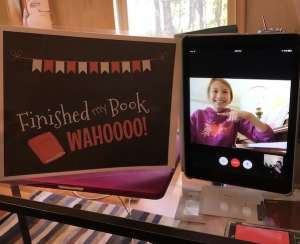
Tips for Distance Teaching - Part 2
Motivating students and overcoming the constraints of the internet – how several Teaching Artists are facing the challenges of virtual teaching and discovering what they enjoy most
Everyone who has recently moved their work online has been grappling with using technology in new ways, but music making and teaching poses unique challenges when confined to video communication. As musicians, we’re all figuring this out together, and these five teaching artists are eager to share what is working for them in their online lessons and also what they’re enjoying the most!
This is the completion of a two-part post where teaching artists share their experiences with virtual teaching. Part 1 focuses on the logistics such as basic set-up, video platforms and other technology, and external microphones, but this post goes into motivational tools and overcoming challenges specific to music, such as adjusting the way a student physically relates to their instrument and helping students practice timing without being able to interact with them in real time.
Meet the contributing teachers!

Erica Cherry
Clarinet and piano
Ages 6 to adult
Harleysville, PA
 Diana Wuli
Diana Wuli
Cello
Ages 9-78(!)
Melbourne, Australia
some students in the US
 Emmy Rozanski
Emmy Rozanski
Trombone, euphonium, & tuba
Ages 10 to adult
Milwaukee, WI
Check out her picture book Mr. Fitch Joins the Band.
 Aniela Eddy
Aniela Eddy
Violin
Ages 4-18
NY, NY
 Stephen Hughes
Stephen Hughes
Trumpet, trombone, euphonium, tuba, & piano lessons
Ages 3-22
Public school band, orchestra, and jazz band
Santa Barbara, CA
Motivating in New Ways:
Many teachers are using traditional ways to motivate their students but adapting them to work at a distance. Erica already had her students set up in an online community on her Facebook page, so she is continuing to celebrate their achievements there, such as when a student completes a new method book.
Emmy is planning a recital and sees advantages to holding it on Zoom instead of in person as her previous studio recitals have been:
I think it will be especially nice because the students of different ages will get to hear and inspire each other. Usually the high school students would just hear other high school students and the middle school students would only hear other middle school students.
Diana has started holding studio classes and also sees the benefit of them being online. She recently move home to Melbourne, Australia from the US and has students in both countries:
I have also added fortnightly virtual studio classes, where students can play for each other and give each other productive feedback. This wasn’t possible before as students lived in different areas, but now, we can all be together no matter which city, state, or country!
Encouraging Practicing
Many teachers are trying out new methods to keep their students motivated and working hard. Aniela is keeping her students extremely organized with practice notes and a schedule for using their time in between lessons:
After each lesson, I spend an extra 30-45 minutes typing up detailed practice notes for each student and record specific practice videos for them to use throughout the week. I also include deadlines for accomplishing specific assignments throughout the week. I want them to send in videos on assigned days so that I can watch their progress and see how they are comprehending the material. After watching their videos, I respond to them/or to their parents with additional feedback or I will send them new repertoire or exercises to work on.
Stephen has created a practice competition for his public school ensembles:
I’ve started a competition related to SmartMusic, which tracks every student’s practice time. With all the down time, I’ve been writing arrangements for my classes to record before the end of the year: Orchestra, Beginning Band, Jazz Band, Advanced Band. The group that clocked the most practice time, got their music first. Orchestra won the first week with “Lean on Me” by Bill Withers!
He’s also keeping his classes fun!
We’ve done competitions to see who has the best background to their Zoom videos in classes. So far the consistent winner has been the kid who showed up with lots of toilet paper in his background on the first day of class.
Overcoming Challenges
Teachers are missing the personal interaction with students and struggling with video disfunction but are making the best of their teaching with what they can do at a distance. Erica shares:
I truly believe that teaching remotely takes a different energy level, and a more thorough level of preparation… I am usually an energetic teacher, but without the feedback of student energy I have learned to conserve a little bit more throughout my day. It is okay to rely on parents for help (especially for younger students).
In terms of actual teaching, I am trying to focus on the areas that work really well in remote lessons (rhythm work, ear-training, ‘rote’ learning when appropriate, for example), and focus less on concepts like very nuanced tone, that is hard sometimes to do over an internet connection. There will be a time for everything!
Teaching Physical Motion
Aniela breaks down the challenge of not being able to use movement to work with her students and how she has learned to manage it with advanced and young beginner students:
The violin is such a physically demanding instrument and requires coordination between the bow arm and the violin arm. In order for younger students or beginners to fully understand certain concepts, I often help them by gently emulating a motion in their arm so that they are able to gain a feeling for the technical movement during their own practice sessions…Proper practice should incorporate an awareness of feeling in each motion, an understanding of the points of contact (when shifting, for example) and the timing that it takes for the body to physically manage the technical task at hand.
For older and more advanced students:
I have learned to break down each motion through the use of descriptions and analogies. It is my job to try and find something that the student can relate to so that they are able to fully comprehend a concept.

For younger students:
The process is similar with younger students except that one of their parents is always close at hand and fully present during the lessons. I will often instruct the parent on what they can do to help their child gain a better feeling of a physical movement.
Teaching Time
Stephen feels that his students are struggling the most with timing, so he is using online software and creating recordings to help them without being in the same room (see the first part of this post for advice on how to make your own!):
Whether playing in a large ensemble or a one-on-one lesson, they can keep time more easily when playing with others than by themselves. Fortunately, SmartMusic allows my school ensembles to play along with Midi recordings, both of their parts and the rest of the ensemble.
Diana is also frustrated by being unable to play along with her students but is making recordings to help them practice in spite of that:
Most software don’t support multiple audio signals at the same time, which is why other people are muted when you’re talking or vice versa. I would love to accompany my students, or play the second cello line to a piece, but at present, I can only pre-record and send the audio file to my students to play along.
A few of their favorite things:
Despite the other challenges, teachers are enjoying the ease of teaching from their homes and the human connection that it is providing them during this time of forced separation. Emmy shares:
I enjoy not having long commutes and appreciate that I can still see my students smiling faces even if not in person.
Diana is enjoying seeing her global studio connect online:
Music can still bring people together, regardless of where you are. To see my students from 2 different continents having studio class together is simply a wonderful sight.
When asked what she is enjoying most, Erica says:
I get to see my students! Families are grateful for both a sense of normalcy, and a chance to try something new. I get to wear my slippers, it’s way easier to sneakily snack during long teaching stretches, and my pets come in the studio now!
She has also noticed this format works better for some:
For a handful of my students, remote lessons have totally (positively) changed their learning. They are just so comfortable in their own homes that they are more focused, happier, and more receptive in their lessons.
She is not the only one who has noticed positive growth during this time. Stephen shares:
I really enjoy seeing the creativity of the students. A lot of kids are sitting at home without much to do. They come in with pieces they’ve looked up themselves, or heard on Spotify. They’ve shared compositions and videos or themselves playing, just for fun! It’s fun to see how resourceful they are, and how meaningful music is to them at this time.
Teaching from home also means that Stephen gets to work with his favorite assistant Elowin!
Being Adaptable
Despite its challenges, virtual teaching is bringing out new creativity in teachers and students as well as providing much needed human connections during this time when we are physically isolated. Music students’ continued motivation is a happy reminder of the importance of art in our lives. Whether you are a musician, teacher, both, or neither, I hope that the ideas shared by these teaching artists inspires you, either in your work or just your confidence in your own adaptability in this strange time. Erica’s final thoughts can ring true for anyone:
There are so many resources online, but it is easy to get overwhelmed. I think all the time of Teaching Artist Eric Booth’s idea that “80% of what you teach is what you are.” You still have the same skills that you did when you were teaching in person – and it is no small thing to be a consistent and supportive adult presence in a students’ life right now. Be adaptable, but don’t feel like you have to reinvent the wheel.
Double Bassist Andrea Beyer is an avid performer, teacher and advocate for using music as a tool for social growth. As an orchestral musician, Andrea has performed in concerts at Carnegie Hall and Lincoln Center, as well as national halls in Central and South America and Asia. A fellow at the New World Symphony from 2017-2020, she gained a passion for creative concert design when she conceived of and presented concerts geared towards new audiences, including “Face-off: Battle of the Instruments” and “Music from Beyond the Wall.”
Outside of the orchestral world, Andrea is a passionate teacher and is on the faculty of Bass Works, a summer double bass program in Baltimore, Maryland. She is also the Public Relations Director and a Workshop Coordinator for the MusAid Organization, which supports music programs in under-resourced countries with volunteer music teaching workshops. Andrea holds a Bachelors Degree from Oberlin Conservatory where she studied with Thomas Sperl and a Masters Degree from Yale University where she studied with Don Palma.
Currently based in Austin, Texas, you can connect with Andrea at andreabeyerbass.com or find her on Instagram @wandering_bassline.

